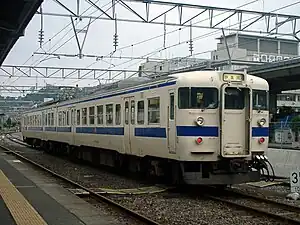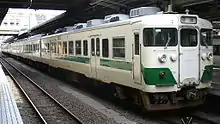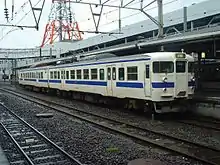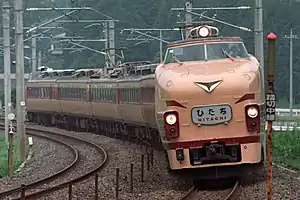717 series
The 717 series (717系) was a Japanese AC electric multiple unit (EMU) train type first introduced by Japanese National Railways (JNR) in March 1985 and later operated on local services by the East Japan Railway Company (JR East) and Kyushu Railway Company (JR Kyushu).[1] The units were formed by converting former AC/DC dual-voltage 451 series, 453 series, 457 series, and 475 series EMUs.[1]
| 717 series | |
|---|---|
 JR Kyushu 717-200 series set, August 2003 | |
| In service | March 1985–July 2014 |
| Scrapped | 2006– |
| Number built | 46 vehicles (18 sets) |
| Number in service | None |
| Number preserved | None |
| Number scrapped | 46 vehicles (18 sets) |
| Successor | 817 series, E721 series |
| Formation | 2/3 cars per trainset |
| Fleet numbers | HK201–207 |
| Operator(s) | JNR (1985–1987) JR East (1987–2008) JR Kyushu (1987–2014) |
| Depot(s) | Kagoshima |
| Specifications | |
| Car body construction | Steel |
| Car length | 20,000 mm (65 ft 7 in) |
| Width | 2,946 mm (9 ft 8 in) |
| Doors | 2 pairs per side |
| Maximum speed | 110 km/h (70 mph) |
| Traction system | Resistor control |
| Electric system(s) | 20 kV AC 50 Hz (717-0/100 series) 20 kV AC 60 Hz (717-200/900 series) |
| Current collector(s) | Overhead catenary |
| Coupling system | 451 series, 453 series |
| Track gauge | 1,067 mm (3 ft 6 in) |
Variants
- 717-0 series: 3-car 20 kV AC 50 Hz sets converted from former 451 series cars for use in the Sendai area
- 717-100 series: 3-car 20 kV AC 50 Hz sets converted from former 451 and 453 series cars for use in the Sendai area
- 717-200 series: 7 x 2-car 20 kV AC 60 Hz sets converted from November 1986 from former 475 series cars for use in Kyushu
- 717-900 series: One 2-car 20 kV AC 60 Hz set converted from former 457 series cars for use in Kyushu
717-0 series

Five 3-car 20 kV AC 50 Hz sets were converted from former 451 series cars with new bodies for use in the Sendai area on Tohoku Main Line and Joban Line local services.[2]
These sets were painted cream ("Cream No. 10") with a green bodyside stripe.[3]
The last remaining set was withdrawn in August 2008.[4]
Formations
The five 3-car sets, numbered T1 to T5, were formed as follows.[3]
| Designation | Mc | M' | Tc' |
|---|---|---|---|
| Numbering | KuMoHa 717 | MoHa 716 | KuHa 716 |
The MoHa 716 car was fitted with one lozenge-type pantograph.[3]
Interior
These sets were made entirely no-smoking from 22 March 1997.[3]
 Original interior style, November 2007
Original interior style, November 2007 Interior with later seat moquette style, November 2007
Interior with later seat moquette style, November 2007
717-100 series
Five 3-car 20 kV AC 50 Hz sets converted from former 451 and 453 series cars with new bodies for use in the Sendai area on Tohoku Main Line and Joban Line local services.[2]
These sets were painted cream ("Cream No. 10") with a green bodyside stripe.[3]
717-200 series

7 x 2-car 20 kV AC 60 Hz sets were converted from former 475 series cars with new bodies from November 1986 at JNR's Kokura and Kagoshima factories for use in Kyushu.[1] The body design of these sets was identical to the earlier 713 series, with two pairs of sliding doors on each side.[1] Four sets (HK201 to HK204) were converted in fiscal 1986, and three more sets (HK205 to HK207) were converted in fiscal 1987.[7] The latter batch differed in having no door pocket windows.[7]
These sets were painted white with a blue bodyside stripe.[1]
As of January 2013, only sets HK203 and HK204 are in service, used on early morning and late night services only in the Kagoshima area, with all other sets withdrawn or stored pending withdrawal.[7] Both sets were later withdrawn in 2014 with the increasing number of 817 series cars on the railway.[8]
717-900 series

One 2-car 20 kV AC 60 Hz set was converted from former 457 series cars in March 1995 for use in Kyushu, based at Kagoshima Depot.[7] The conversion work involved adding another pair of sliding doors in the centre of each side.[1]
Internally, some of the original transverse seating bays were replaced with longitudinal bench seating.[1]
The sole 717-900 series set was withdrawn in December 2010.[10]
Formation
The single 2-car set, HK901, was formed as follows.[1]
| Designation | Mc | Mc' |
|---|---|---|
| Numbering | KuMoHa 717-901 | KuMoHa 716-901 |
KuMoHa 717-901 was converted from KuMoHa 457-14, and KuMoHa 716-901 was converted from former intermediate car MoHa 456-14 with the cab end from 455 series KuHa 455-601.[1]
Interior
 Interior of KuMoHa 717-901, February 2007
Interior of KuMoHa 717-901, February 2007
Withdrawal
The last two sets were withdrawn in July 2014. No 717 series cars have been preserved.
References
- JR全車輌ハンドブック2009 [JR Rolling Stock Handbook 2009]. Japan: Neko Publishing. 2009. p. 310. ISBN 978-4-7770-0836-0.
- JR全車輛ハンドブック1995 [JR Rolling Stock Handbook 1995]. Japan: Neko Publishing. 1995. pp. 273–274.
- JR電車編成表 '98夏号 [JR EMU Formations – Summer 1998]. Japan: JRR. July 1998. p. 23. ISBN 978-4-88283-029-0.
- "JR車両のデータバンク" [JR rolling stock data bank]. Japan Railfan Magazine (in Japanese). 49 (579): Appendix 35. July 2009.
- "JR車両のデータバンク" [JR rolling stock data bank]. Japan Railfan Magazine (in Japanese). 48 (567): Appendix 36. July 2008.
- "JR車両のデータバンク" [JR rolling stock data bank]. Japan Railfan Magazine (in Japanese). 47 (555): Appendix 36. July 2007.
- Saka, Masahiro (February 2013). "JR九州近郊型電車の現況" [The current state of JR Kyushu outer-suburban EMUs]. Tetsudō Daiya Jōhō Magazine (in Japanese). 42 (346): 14–31.
- JR電車編成表 2015冬 [JR EMU Formations – Winter 2015]. Japan: JRR. November 2015. p. 230. ISBN 978-4-330-33112-6.
- JR電車編成表 2013冬 [JR EMU Formations – Winter 2013]. Japan: JRR. November 2012. p. 358. ISBN 978-4-330-51614-1.
- "717系Hk901編成とHk6編成が小倉工場へ" [717 series set HK901 and HK6 sent to Kokura]. Japan Railfan Magazine Magazine Online (in Japanese). Japan: Koyusha Co., Ltd. 15 December 2010. Retrieved 15 January 2013.
External links
- "JR East 717 series". jreast.co.jp. Archived from the original on 25 February 2007. Retrieved 15 January 2013. (in Japanese)

